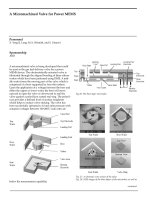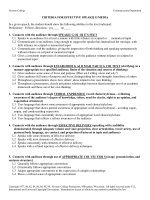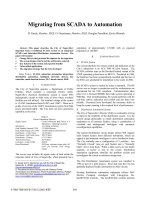Tài liệu Guidelines for Employers to Reduce Motor Vehicle Crashes docx
Bạn đang xem bản rút gọn của tài liệu. Xem và tải ngay bản đầy đủ của tài liệu tại đây (250.93 KB, 35 trang )
Guidelines for Employers to
Reduce Motor Vehicle Crashes
This document represents a joint effort by NETS,
NHTSA and OSHA to reduce motor vehicle-related
deaths and injuries in the nation’s workforce.
This [white paper] was funded under [Purchase Order Number B-9-4-2-
3576] for the U.S. Department of Labor, Occupational Safety and Health
Administration. The views expressed herein do not necessarily represent
the official position or policy of the U.S. Department of Labor.
This document is not a standard or regulation, and it creates no new legal
obligations. Likewise, it cannot and does not diminish any obligations
established by Federal or state statute, rule, or standard. The document is
advisory in nature, informational in content, and is intended to assist
employers in providing a safe and healthful workplace. The Occupational
Safety and Health Act requires employers to comply with hazard-specific
safety and health standards. In addition, pursuant to Section 5(a)(1), the
General Duty Clause of the Act, employers must provide their employees
with a workplace free from recognized hazards likely to cause death or
serious physical harm. Employers can be cited for violating the General
Duty Clause if there is a recognized hazard and they do not take reason-
able steps to prevent or abate the hazard.
Every 12 minutes someone dies in a motor
vehicle crash, every 10 seconds an injury
occurs and every 5 seconds a crash occurs.
Many of these incidents occur during the
workday or during the commute to and from
work. Employers bear the cost for injuries that
occur both on and off the job. Whether you
manage a fleet of vehicles, oversee a mobile
sales force or simply employ commuters, by
implementing a driver safety program in the
workplace you can greatly reduce the risks
faced by your employees and their families
while protecting your company’s bottom line.
1
Set Up a Safe Driving Program to Keep
Your Employees Safe on the Road
2
Motor vehicle crashes are a leading cause of death and injury
for all ages. Crashes on and off the job have far-reaching
financial and psychological effects on employees, their co-
workers and families, and their employers.
You need a driver safety program:
• To save lives and to reduce the risk of life-altering injuries
within your workforce.
• To protect your organization’s human and financial
resources.
• To guard against potential company and personal liabilities
associated with crashes involving employees driving on
company business.
Your program should work to keep the driver and those
with whom he/she shares the road safe. And, if necessary,
the program must work to change driver attitudes, improve
behavior, and increase skills to build a “be safe” culture. By
instructing your employees in basic safe driving practices and
then rewarding safety-conscious behavior, you can help your
employees and their families avoid tragedy.
3
Employees are an employer’s most valuable assets. Workplace
driver safety programs not only make good business sense
but also are a good employee relations tool, demonstrating
that employers care about their employees.
This booklet outlines ten steps for building a driver safety
program in your workplace. These steps will be useful to
any organization regardless of size of the organization, type
of traffic encountered, number of vehicles involved, or
whether employees drive company or personal vehicles for
work purposes. Also included are real-life examples of
successful safety programs, key traffic safety issues to address
in the workplace, instructions for calculating your organiza-
tion’s loss from motor vehicle crashes, and a list of resources
to help you fine-tune your program.
Motor vehicle crashes cost employers $60 billion annually in
medical care, legal expenses, property damage, and lost pro-
ductivity. They drive up the cost of benefits such as workers’
compensation, Social Security, and private health and disability
insurance. In addition, they increase the company overhead
involved in administering these programs.
The average crash costs an employer $16,500. When a worker
has an on-the-job crash that results in an injury, the cost to
their employer is $74,000. Costs can exceed $500,000 when a
fatality is involved. Off-the-job crashes are costly to employers
as well.
1
The real tragedy is that these crashes are largely preventable.
Recognizing the opportunity that employers have to save lives,
a growing number of employers have established traffic safety
programs in their companies. No organization can afford to
ignore a major problem that has such a serious impact on both
their personnel and the company budget.
1
NHTSA [2003]. The economic burden of traffic crashes on employers: costs by
state and industry and by alcohol and restraint use. Publication DOT HS 809 682.
4
Promoting Safe Driving Practices
Helps Your Bottom Line
5
To understand the impact of motor vehicle crashes on your
organization, use the Costs of Traffic Crashes to Employers
Worksheet, found at the end of this booklet, to calculate the
cost of your crashes. You may want to initially select one
recent crash to illustrate the magnitude and complexity of such
losses. Once you master the worksheet for one crash, you can
then apply it to all the crashes experienced in a chosen time
frame (e.g., annually) within your organization to characterize
your crash loss profile.
Once you know the costs associated with motor vehicle crash-
es you will realize that the costs associated with implementing
a driver safety program are minimal compared to the costs of
crashes to your organization. Examples abound of the positive
return-on-investment (ROI) realized by companies – small,
medium, and large – that have implemented well-designed safe-
ty programs for the benefit of their employees. In fact, the
Liberty Mutual Insurance Company reported in 2001 that,
based on its Executive Survey of Workplace Safety, 61 percent
of surveyed business executives believe their companies receive
an ROI of $3.00 or more for every $1.00 they spent on
improving workplace safety.
2
2
Liberty Mutual Insurance Company [2001]. Liberty Mutual Executive Survey of
Workplace Safety.
Calculate Your Costs for Motor
Vehicle Crashes
6
7
Depending on the size of your organization, you may have
access to all of the data that you need. Or you may need to
work with your human resource manager, safety manager,
workers’ compensation representative, accountants, and med-
ical and motor vehicle insurance representatives to obtain the
numbers you'll need.
Costs of Motor Vehicle Crashes to Employers Worksheet
Use the worksheet found at the end of this booklet to estimate
the cost of a motor vehicle crash to your organization. The
costs included on the worksheet will be estimates based upon
the records, receipts and recall of those involved with the
crash. It may be helpful to consult copies of accident reports,
police reports, damage receipts, insurance claim records and
payroll records. It is often very difficult to identify all costs
associated with these crashes, so use the best information you
have available. If your company incurred expenses not listed
on the worksheet, be sure to include them.
Where to Start
8
Many companies have already benefited from the approach to driver safety out-
lined in this booklet. Here's how:
Nationwide Insurance - Columbus, Ohio
Program:
• Nationwide, one of the largest insurance and financial services companies in
the United States, operates a large, private motor vehicle fleet.
• In 1998, Nationwide developed and implemented a comprehensive motor
vehicle safety program using a 10-step program as outlined in this booklet.
Results:
• While the number of miles driven by Nationwide associates has increased by
19 percent, the organization’s preventable crashes have decreased by 53 percent.
• The organization’s total motor vehicle loss costs are down 40 percent.
Charter Communications – Michigan
Program:
• Charter Communications provides cable service to Michigan residents. With a
fleet of over 650 vehicles, Charter employees drive 1.5 million miles per month.
• In early 2001, the company began a program to increase seat belt use among
their company drivers. Charter worked with Michigan NETS to establish a
corporate seat belt program and to reward seat belt use.
• Participation in the NETS annual Drive Safely Work Week campaign and the
NHTSA “Safety Belt Award Program” were both used to support the corpo-
rate program.
• During this same period, Charter began a defensive driving program for
employees.
Results:
• In 2001, Charter-Michigan Region’s seat belt use rate was 74 percent. In two
years, they reached a 94 percent seat belt use rate and have continued to
maintain that rate.
Success Stories: Workplace Driver
Safety Programs in Action
9
• They also experienced a 30 percent decrease in motor vehicle crashes during this
time.
General Motors Corporation - Detroit, Michigan
Program:
• GM, the world’s largest vehicle manufacturer, implemented the Safe Driving
Program, “Create the Habit,” for over 250,000 employees in November 1998.
• This comprehensive initiative provided workplace education programs and strict
seat belt usage policies.
• An incentive program was developed to recognize and reward seat belt use. GM
surveyed 90 sites each quarter.
Results:
• GM increased employee seat belt usage from 61 percent in 1998 to 85 percent by
December 2003. Ongoing awareness programs continue to promote the safety
message.
• The Safe Driving Program is credited with saving five lives a year.
Pike Industries - Barre, Vermont
Program:
• Pike Industries, an asphalt paving company, has approximately 250 employees in
Vermont. They operate the 280 vehicles (pickups, tractor-trailers, dump trucks,
etc.) in the fleet.
• Their fleet safety program requires all new drivers to receive classroom training;
each is assigned a veteran “mentor.” Veteran drivers attend annual classroom
training, reviewing topics that include federal regulations and accident avoidance
techniques.
• All drivers attend weekly “toolbox” talks to discuss fleet safety topics.
Results:
• Company drivers traveled over 2 million miles in 2003 hauling construction
equipment and materials, performing construction activities (many were in highly
dangerous work zones) and did not have any significant roadway incidents.
• Workers’ compensation claims for vehicle incidents dropped from a high of 73
percent of total losses in 2001 to 2 percent in 2003. Vehicle property damage
losses also followed this trend.
10
NETS 10-Step Program to Minimize Crash Risk
The 10-Step Program provides guidelines for what an employer
can do to improve traffic safety performance and minimize the
risk of motor vehicle crashes. Following these steps helps to
ensure that you hire capable drivers, only allow eligible drivers
to drive on company business, train them, supervise them, and
maintain company vehicles properly. Adherence to these 10
steps can also help to keep your motor vehicle insurance costs
as low as possible.
1. Senior Management Commitment & Employee Involvement
2. Written Policies and Procedures
3. Driver Agreements
4. Motor Vehicle Record (MVR) Checks
5. Crash Reporting and Investigation
6. Vehicle Selection, Maintenance and Inspection
7. Disciplinary Action System
8. Reward/Incentive Program
9. Driver Training/Communication
10. Regulatory Compliance
These steps are from the NETS Traffic Safety Primer: A Guidebook for Employers.
11
Step 1: Senior Management Commitment and
Employee Involvement
The safety of an organization’s employees as they drive for
work and to and from work is so important that it requires the
attention of top-level management. Senior management can
provide leadership, set policies, and allocate resources (staff
and budget) to create a safety culture. Actively encouraging
employee participation and involvement at all levels of the
organization is a good practice and will help the effort to
succeed. Workers and their representatives must be involved
in the initial planning phase.
12
Step 2: Written Policies and Procedures
A written statement emphasizing the commitment to reducing
traffic-related deaths and injuries is essential to a successful
program. Create a clear, comprehensive and enforceable set
of traffic safety policies and communicate them to all employ-
ees. These are the cornerstones of an effective driver safety
program. Post them throughout the workplace, distribute
copies periodically, and discuss the policies at company meet-
ings. Offer incentives for sticking to the rules, and point out
the consequences of disregarding them. Below are sample
policies that can be adapted for use by your company.
Sample Alcohol and Drug Use Policy
(Name of Company/Organization) has a vital interest in
maintaining safe, healthy, and efficient working conditions
for its employees. Therefore, the consumption of alcohol or
illegal drugs by any employee during “duty hours” is prohib-
ited. Duty hours consist of all working hours, including
break periods and on-call periods, whether on or off company
premises. The consumption of alcohol or illegal drugs while
performing company business or while in a company facility
is prohibited.
13
Sample Seat Belt Use Policy
(Name of Company/Organization) recognizes that seat belts
are extremely effective in preventing injuries and loss of life.
It is a simple fact that wearing your seat belt can reduce your
risk of dying in a traffic crash by 45 percent in a car and by
as much as 60 percent in a truck or SUV.
We care about our employees, and want to make sure that
no one is injured or killed in a tragedy that could have been
prevented by the use of seat belts. Therefore, all employees of
(Name of Company/Organization) must wear seat belts when
operating a company-owned vehicle, or any vehicle on com-
pany premises or on company business; and all occupants are
to wear seat belts or, where appropriate, child restraints
when riding in a company-owned vehicle, or in a personal
vehicle being used for company business. All employees and
their families are strongly encouraged to always use seat belts
and the proper child restraints whenever they are driving or
riding in any vehicle, in any seating position.
14
Step 3: Driver Agreements
Establish a contract with all employees who drive for work
purposes, whether they drive assigned company vehicles or
drive their personal vehicles. By signing an agreement, the
driver acknowledges awareness and understanding of the
organization’s traffic safety policies, procedures, and expecta-
tions regarding driver performance, vehicle maintenance and
reporting of moving violations.
Step 4: Motor Vehicle Record (MVR) Checks
Check the driving records of all employees who drive for
work purposes. You must screen out drivers who have poor
driving records since they are most likely to cause problems
in the future. The MVR should be reviewed periodically to
ensure that the driver maintains a good driving record.
Clearly define the number of violations an employee/driver
can have before losing the privilege of driving for work, and
provide training where indicated.
Step 5: Crash Reporting and Investigation
Establish and enforce a crash reporting and investigation
pro-cess. All crashes, regardless of severity, should be report-
ed to the employee’s supervisor as soon as feasible after the
incident. Company traffic safety policies and procedures
should clearly guide drivers through their responsibilities in a
crash situation. All crashes should be reviewed to determine
their cause and whether or not the incidents were preventa-
ble. Understanding the root causes of crashes and why they
are happening, regardless of fault, forms the basis for elimi-
nating them in the future.
15
Step 6: Vehicle Selection, Maintenance and Inspection
Selecting, properly maintaining and routinely inspecting
company vehicles is an important part of preventing crashes
and related losses.
It is advisable that the organization review and consider the
safety features of all vehicles to be considered for use. Those
vehicles that demonstrate “best in class” status for crash-
worthiness and overall safety should be chosen and made
available to drivers.
For the latest information on crash test ratings and other
important vehicle safety information, visit www.safercar.gov.
To report a concern about a defect or problem with your
vehicle, contact the NHTSA Auto Safety Hotline at:
1-888-DASH-2-DOT.
Vehicles should be on a routine preventive maintenance
schedule for servicing and checking of safety-related equip-
ment. Regular maintenance should be done at specific
mileage intervals consistent with the manufacturer’s recom-
mendations. A mechanic should do a thorough inspection of
each vehicle at least annually with documented results placed
in the vehicle’s file.
Personal vehicles used for company business are not necessarily
subject to the same criteria and are generally the responsibility
of the owner. However, personal vehicles used on company
business should be maintained in a manner that provides the
employee with maximum safety and reflects positively on the
company.
16
Step 7: Disciplinary Action System
Develop a strategy to determine the course of action after the
occurrence of a moving violation and/or “preventable” crash.
There are a variety of corrective action programs available;
the majority of these are based on a system that assigns
points for moving violations. The system should provide for
progressive discipline if a driver begins to develop a pattern
of repeated traffic violations and/or preventable crashes. The
system should describe what specific action(s) will be taken
if a driver accumulates a certain number of violations or
preventable crashes in any pre-defined period.
Step 8: Reward/Incentive Program
Develop and implement a driver reward/incentive program to
make safe driving an integral part of your business culture.
Safe driving behaviors contribute directly to the bottom line
and should be recognized as such. Positive results are realized
when driving performance is incorporated into the overall
evaluation of job performance. Reward and incentive programs
typically involve recognition, monetary rewards, special privi-
leges or the use of incentives to motivate the achievement of a
predetermined goal or to increase participation in a program
or event.
17
Step 9: Driver Training/Communication
Provide continuous driver safety training and communica-
tion. Even experienced drivers benefit from periodic training
and reminders of safe driving practices and skills. It is easy to
become complacent and not think about the consequences of
our driving habits.
Step 10: Regulatory Compliance
Ensure adherence to highway safety regulations. It is important
to clearly establish which, if any, local, state, and/or federal
regulations govern your vehicles and/or drivers. These regula-
tions may involve, but may not necessarily be limited to the:
• Federal Motor Carrier Safety Administration (FMCSA)
• U.S. Department of Transportation (USDOT)
• National Highway Transportation Safety Administration
(NHTSA)
• Federal Highway Administration (FHWA)
• Employment Standards Administration (ESA)
18
The increasing traffic congestion on our nation’s roadways
wastes significant time and money, reduces productivity and
promotes risky driving behavior. Employees may feel pres-
sured to drive faster and for longer periods of time and to
engage in potentially distracting in-vehicle activities to meet
their job responsibilities. Engaging in unsafe driving practices
affects those who occasionally drive their personal vehicles for
work purposes as well as those who spend their workday
driving a company vehicle.
As an employer, do your part by keeping your parking lot
well lighted and well maintained. Keep roadway and parking
spaces properly striped, and clear of debris and snow. Install
signs at parking lot exits reminding employees to buckle their
seat belts and drive safely. Let your concern for their safety
be their final thought as they leave your parking lot.
Employers have enormous power to protect their businesses
by educating their employees about safe driving practices.
The safety issues described below should be addressed in an
employee awareness and training program.
More detailed information on Aggressive Driving, Distracted
Driving, Drowsy Driving and Impaired Driving can be found
beginning on page 27.
Promote Safe Driving Practices to Protect
Your Most Valuable Investment – Your Employees
19
Secure Materials for Transport
Tools or equipment should be secured while being transported
to prevent unsafe movement of materials. During a crash or
when making sudden maneuvers, loose objects can slide
around or become airborne, injuring the driver and any
passengers. Objects that could become a hazard should be
secured or stored outside the passenger compartment.
Seat Belt Use
Seat belts are the single most effective means of reducing
deaths and serious injuries in traffic crashes. As the most
effective safety device in vehicles, they save nearly 12,000
lives and prevent 325,000 serious injuries in America each
year. During a crash, anyone not wearing a seat belt will slam
into the steering wheel, windshield, or other parts of the
interior, or be ejected from the vehicle.
Distracted Driving
Distracted driving is a factor in 25 to 30 percent of all traffic
crashes. With hectic schedules and roadway delays, many
employees feel pressured to multi-task just to keep up with
their personal and work-related responsibilities. More time
on the road means less time at home or at work but “drive
time” can never mean “down time.” Since drivers make more
than 200 decisions during every mile traveled, it’s critical for
employers to stress that when driving for work, safe driving
is their primary responsibility.
20
Alcohol and Drug Impaired Driving
Alcohol use is involved in 40 percent of all fatal motor vehicle
crashes, representing an average of one alcohol-related fatality
every 30 minutes. It is estimated that three in every 10
Americans will be involved in an impaired driving-related
crash some time in their life. Alcohol, certain prescription
drugs, over-the-counter medications, and illegal drugs can
all affect a person’s ability to drive safely due to decreased
alertness, concentration, coordination and reaction time.
Busi-nesses pay a high price for alcohol and drug abuse;
alcohol is a contributing factor in 39 percent of all work-
related traffic crashes.
Fatigued Driving
Fatigued or drowsy driving may be involved in more than
100,000 crashes each year, resulting in 40,000 injuries and
1,550 deaths. Sadly, these numbers represent only the tip of
the iceberg since these crashes are seriously under-reported.
These days, it’s more important than ever for employees to be
well rested, alert and sober on the road so that they are in a
position to defend themselves from drivers who do not make
the same choice. Train employees to make smart decisions
when they’re behind the wheel, on and off the job.
21
Aggressive Driving
Employees commuting to and from work and traveling for
work purposes often find themselves caught up in bottlenecks
and traffic delays, wasting their time and reducing their pro-
ductivity. These situations create a high level of frustration
that can spark aggressive driving behavior. The roadway is
one place that being aggressive never pays.
Aggressive driving acts include excessive speed, tailgating,
failure to signal a lane change, running a red light and passing
on the right. The best advice is to avoid engaging in conflict
with other drivers and to allow others to merge.
22
Young Drivers
The 16-20-year-old population represents a significant high-
way safety problem. Traffic crashes are the leading cause of
fatalities for teens. Historically, this group is the age group
that has the lowest seat belt use rate and is the most likely to
engage in risky driving behaviors that include: speeding,
driving while alcohol or drug impaired and when drowsy. It
is important for employers with young workers to actively
promote safe driving practices.
We have learned much about teen driver safety during the
past decade. There are proven, specific safety benefits from a
variety of best practices that are commonly referred to as
“graduated driver licensing” or GDL. GDL practices have
resulted in substantial reductions in crashes, injuries and
fatalities for novice teenage drivers.
Under Federal law, 16-year-old workers are prohibited from
driving as part of their job, and 17-year-olds may drive for
work only under strictly limited circumstances. Some state
laws may be more restrictive than Federal laws. For more
information on child labor laws visit,
www.youthrules.dol.gov or www.cdc.gov/niosh/topics/youth/.
Once your driver safety program is operational, consider
extending it to your employees' families and members of
your community. Employers are in a position to foster safe
driving practices and reduce the number of traffic crashes in
their communities. Employer programs not only inform
employees about traffic hazards and educate them about
responsible driving practices but they can create a safer road-
way environment for the entire community.
Four reasons for reaching out to employees' families and
members of the community:
• Provides public relations benefits for your company.
• Boosts employee morale.
• Creates a safer driving environment for your employees,
their dependents, and members of the community.
• Reduces employer and employee healthcare costs.
Reach Out to Family and
Community Members
23









